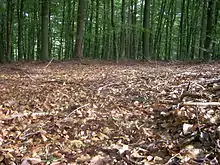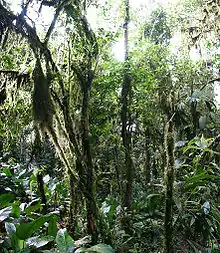Forest floor
The forest floor, also called detritus, duff and the O horizon, is one of the most distinctive features of a forest ecosystem. It mainly consists of shed vegetative parts, such as leaves, branches, bark, and stems, existing in various stages of decomposition above the soil surface. Although principally composed of non-living organic material, the forest floor also teems with a wide variety of fauna and flora. It is one of the richest components of the ecosystem from the standpoint of biodiversity because of the large number of decomposers[1] and predators present, mostly belonging to invertebrates, fungi, algae, bacteria, and archaea. Certain (adapted) plants may be more apparent in tropical forests, where rates of metabolism and species diversity are much higher than in colder climates.

The major compartments for the storage of organic matter and nutrients within systems are the living vegetation, forest floor, and soil. The forest floor serves as a bridge between the above ground living vegetation and the soil, and it is a crucial component in nutrient transfer through the biogeochemical cycle. Much of the energy and carbon fixed by forests is periodically added to the forest floor through litterfall, and a substantial portion of the nutrient requirements of forest ecosystems is supplied by decomposition of organic matter in the forest floor and soil surface. The sustained productivity of forests is closely linked with the decomposition of shed plant parts, particularly the nutrient-rich foliage. The forest floor is also an important fuel source in forest fires.

Composition
The amount of material in the forest floor depends on the balance between inputs from litter production and outputs from decomposition, and amounts also reflect the site's disturbance history. Both litter production and decomposition are functions of the site (e.g., wet versus dry; cold versus warm; nutrient rich versus nutrient poor) and the vegetation that occupies the site (e.g., conifer versus broadleaf). A site's forest floor is determined by its areal weight, depth, and nutrient content. Typically, forest floors are heaviest and deepest in boreal forests and mountain forests where decomposition rates are slow. In contrast, the lightest and thinnest forest floors usually occur in tropical forests where decomposition rates are rapid, except on white sands where nutrients could not be supplied from mineral weathering.
Temperate forests

The organic layer is divided into three layers: on the surface is the leaf litter formed by undecomposed vegetable matter; underneath is humus which is the product of decomposed vegetable matter. Between litter and humus is a partially decomposed layer of organic matter ("F: fragmented organic materials")[2] .[3] Some specialists consider this zone to be equivalent to the soil horizon (O) whereas for others, this only includes the humus and the intermediate layer, excluding the litter. Woodland plants that inhabit this zone often have bulbs or rhizomes and include ferns such as bracken, monocots such as bluebells and dog's mercury.

Tropical forests

Because of the action of termites, millipedes and other organisms, the leaf litter layer of tropical forests may be considerably less apparent, or virtually absent at certain times of the year. With up to three defined canopy layers above, relatively low levels of sunlight (as little as 2%) reach here.[4] Examples of the wide range of plants adapted to this zone include: spike mosses, gingers and the parasitic Rafflesia spp.
See also
References
- Ochoa-Hueso, R; Delgado-Baquerizo, M; King, PTA; Benham, M; Arca, V; Power, SA (February 2019). "Ecosystem type and resource quality are more important than global change drivers in regulating early stages of litter decomposition". Soil Biology and Biochemistry. 129: 144–152. doi:10.1016/j.soilbio.2018.11.009.
- Perry DA, Oren R, Hart SC (2008). Forest ecosystems. Johns Hopkins University Press, Baltimore. p. 606. ISBN 9780801888403. OCLC 174138928.
- Waring RH, Running SW (2007). Forest ecosystems: analysis at multiple scales. Elsevier/Academic Press, Amsterdam; Boston. pp. 420. ISBN 9780123706058. OCLC 123818301.
- Bourgeron PS (1983). "Spatial Aspects of Vegetation Structure". In Frank B. Golley (ed.). Tropical Rain Forest Ecosystems. Structure and Function. Ecosystems of the World (14A ed.). Elsevier Scientific. pp. 29–47. ISBN 978-0-444-41986-6.
External links
 Media related to plant litter at Wikimedia Commons
Media related to plant litter at Wikimedia Commons Media related to forest floors at Wikimedia Commons
Media related to forest floors at Wikimedia Commons- Encyclopedia Network: Soil Quality.
- American Museum of Natural History: Forest Floor Diodrama.
- Taltree:Arboretum & Garden: The Forest Floor.